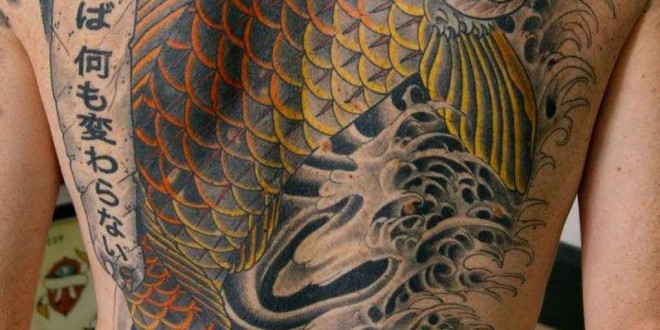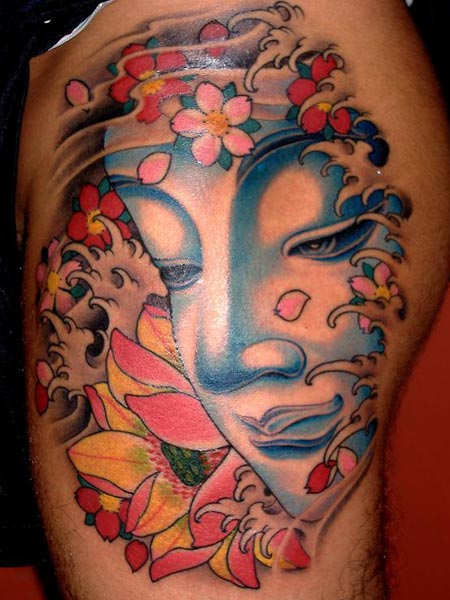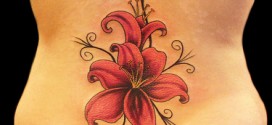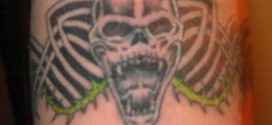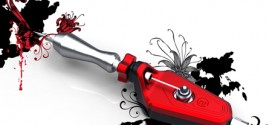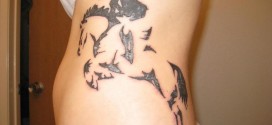ANCIENT ART OF THE JAPANESE TEBORI TATTOO MASTERS | INK IN HARMONY
Taking off from JFK today for a two week trip that will take me on a quick stop at Tokyo, then on to Korea, China, and finally Hong Kong. The zen and artistry of Japanese tattoo has long fascinated me, and with this trip, this post seemed only fitting.
Oguri, known in Japan as Horihide, his tattooing name, is a famous artist and highly regarded as the pioneer that brought Japanese tattooing to American tattooists, like Sailor Jerry, and subsequently Ed Hardy, after World War II. Thus setting the stage for large Asian body suit tattoo design to change the face of western tattooing in the last half of the twenty first century. Here in his own words is his story.
In old days, Japanese tattooists worked at their own houses and ran business quietly (without using the ads.). They didn’t put up a sign and list telephone numbers on the book. The practice of tattooing was forbidden in Japan (until the end of World War II). The customers used to find the tattoo shops by word of mouth.
When I was an apprentice, feudal customs still existed in Japan. The apprenticeship was one of the feudal customs called uchideshi in Japanese. Normally, pupils lived with their masters, and were trained for 5 years. After 5-year training, the pupils worked independently, and gave the masters money that he earned for one year. The one-year service was called oreiboko in Japanese, the service to express the gratitude towards the masters. The masters usually told new pupils about this system, 5-year-training and 1-year service, when they began the apprenticeship.
I slept at the master’s workplace when I was a pupil. I wanted to be a great tattoo artist as soon as possible. In the middle of the night, I picked up the needles from the master’s tool box, sat cross-legged and practiced tattooing on my thigh without the ink, remembering how my master performed. I continued to practice tattooing without using the ink. I used a thick bamboo stick for sujibori (outlining), which was about 20 cm long. The edge of the stick was sharpened, and 6-7 needles were put in order and tied up by silk thread. The length of the tip of needles was 3-4 mm. I wanted to workas a tattooist soon, and practiced incising both my thighs with the bamboo stick every night after work.I did not know how to use the tattooing tools and how to adjust the angles. Sometimes I penetrated the skin very deeply with the needles, and the skin bled and swelled. I could not tattoo by using the bamboo stick as I wanted.During the daytime I did chores. If I had no work during the day, I would sit down on the left side of my master and watch his work from the distance.
Every customer came to the master by appointment and got hitoppori. Hitoppori in Japanese means to get tattooed for 2 hours each day. If a big tattoo was to be done, the customer came by every third day. I used to keep sitting straight for 2 hours and just watching my master’s hands learn his tattooing skills. The master would say to me, “I’m not going to lecture you. You steal my techniques by watching me work.” Watching is the fastest way to learn, rather than listening to the lecture, if people really want to learn something. Even though I was full of enthusiasm, my skills were not improved easily. I couldn’t see any progress at all.
One day, the master’s wife asked me to split wood. (Pupils normally call the master’s wife ane-san or okami-san. The master’s wife looked so happy when I called her ane-san. So I called her ane-san during the apprenticeship.) One day while I was splitting wood in the back yard, I got hotter and hotter. I was in a sweat, and took off my shirt and trousers. Ane-san came and asked me to take a rest. She brought a cup of tea for me. Then, Ane-san happened to see my traces of the needles on the thighs.
She was surprised and said to me, “How did you get scars on the thighs? Do you practice tattooing by yourself?”
“Yes,” I answered, “but I cannot tattoo well like the master does.”
“Have you ever seen my husband’s legs and ankles?” she asked again.
“No.” I said.
She continued, “His whole legs are covered with tattoos. You know what I mean? He told me that he practiced tattooing on his legs with the ink when he was a pupil. That’s why his legs are all black. He also told me that a tattooist needs to learn by tattooing his own body to become a professional tattooist. There is nothing to replace human skin. So you have to learn tattooing by using (tattooing) your body.”
After hearing this story, I remembered the master had tattoos on his arms to wrists but that I had never seen his bare feet. I wondered if Ishould practice tattooing with the ink. Otherwise I couldn’t’t get how the ink was inserted into the skin. I decided to master the techniques until my whole body would be black. “I will never give it up. If I give it up, I won’t be a true man.” Since then, I practiced tattooing on any parts of legs from the thighs to the ankles almost every day. In order to keep practicing again and again, I didn’t’t use the ink when practicing tattooing.
Today’s young people never understand how tough the training was. I used to wake up 5 a.m., and sweep the whole house inside and out. I also wiped thefloor with a damp cloth. In winter, my hands were numb with cold water and got chilblains. My fingers were swollen. At meals, I was allowed to have only one cup of soup and one dish. A bowl of rice was also served. Even though I wanted to eat more, I could not eat enough because I was in training. It was right after World War 2. Due to insufficiency of supplies, it was so hard for us to get enough rice. We would eat a mixture of rice and barley. I was only 19 and always starving. It was tough experience.
Sometimes the master yelled at me and even hit me. To endure such treatment needs patience. Because of such unreasonable treatment, most pupils gave up and ran away from the master. Of course, I often wondered why he hit us. Although I had anger towards the master, I could not talk back. All I could do in the feudal period was to obey what the master said. I was so frustrated that I cried in bed so many times. The master sometimes slapped me without any reason. However, I found the master purposely hit me and forced me to do overwork for my mental training after I became a tattooist later on. I hated him so much during the apprenticeship. Looking back now, I am ashamed of having had such feelings towards my master.
When I was an apprentice, my master taught me how to make tattooing needles. Each tattooist has his own preferred way of making needles. I put 7 needles in order, and curve the tips of them. Then I make a fan-shape with them. The middle of the needles is set as the top of the fan, pulling the rest of them down.The needles should be arranged like the following figure and soldered up.
When incising thin lines, I use 2 or 3 of 7 needles, which are the closest to the hands, by adjusting the angle of the needles with the skin. Normally when tattooing the outline, I touch the skin with only the middle of the group of needles.
To tattoo details, some tattooists use a separate tool consisting of only 3 needles. But the professional tattooists can tattoo whatever they want, using only one set of needles for outlining. They don’t have to use other tattooing tools. They can tattoo any thin or thick lines, small circles and so on. The professional tattooists tattoo the designs on the skin smoothly, from up to down, down to up, right to left, left to right. When I need more ink after tattooing from left to right, for example, I do kaeshibari, flipping the needles. Kaeshibari is one of techniques, which is flipping the other side of the needles and tattooing by using the rest of the ink on the other side.
Horimono means “tattoo” in Japanese. Hori or horu is “to incise” or “to dig” and mono means “things.” Tattooing is similar to engraving a sculpture. A tattoo is not a picture. It is supposed to be appreciated at a distance of several years. What is expressed by the tattoo should be clearly recognized from a distance. If the tattoo is too detailed, it can hardly be seen from a distance. Like sculptures, tattoos need to be rough and drastic to some extent. Such tattoos are more Attractive to people. I can see why tattoos need to be bold after the work is finished.
Tattooing by hand, Tebori, requires special techniques. It should be done by puncturing the skin with the needles gently, adjusting the strength of hands. Human skin is very soft and elastic. As the needles leave the skin, I can hear the sound, shakki. If I tattoo smoothly, I can hear a rhythmical sound like “sha, sha, sha.” I dip the needles in the ink, and tattoo a line about one centimeter long. This same step is done continuously during sujibori (outlining).I keep the same speed (rhythm) to tattoo no matter what kind of designs or shapes, such as circles, squares and lines, are tattooed. I draw the outlines step by step on each part of the body, such as the shoulders, the arms and the back, and finally finish the art work on the body. Then the full body tattoo is completed.
or bokashibori (shading), sets of 12 and 13 needles are prepared, and each set is made in the shape of a fan and soldered. The set of 12 needles is put under the set of 13 needles and staggered by pulling the set of 12 needles back a little bit. When I do bokashibori , I insert the ink into the skin at an angle which corresponds to the angle made by the two sets of needles. I have to adjust the strength of the stroke by using both 12-set needles and 13-set needles. If I use either one or the other, the ink cannot be inserted into the skin properly. The lower 12-set needles has to be used carefully, like touching the needles on the skin gently. It’s very difficult to master how to use those tattoo needles, especially the lower set of needles.
Today, we Japanese tattooists order tattooing needles from the factory. However, when I was a pupil, I would make tattooing needles by using the thinnest sewing needles. Many of them did not have good quality points. One package had 25 needles, and a half of them were no good. In those days, we used the ink called sakurazumi. Now we use baikaboku for tattooing, which is made of soot of cooking oil. The ink for calligraphy, which is made of soot of resin, is not suitable for tattooing, because the color does not last long.
Those needles were often stolen by customers. I assume that some other tattooists asked them to pretend to be customers and to steal my tools, in order to know how I made the tattooing needles. Although I understood that they had eager feelings to learn professional tattooing, I was so angry with the attitudes. When I was tattooing, I put my tool box beside me. While I was away (going to bathroom, for example), they stole my needles. It is not difficult to steal them. After all, I prepare the necessary needles only when I need them. I usually lock the door of my studio after work. Electric machines, color inks, my drawings (about 120 designs) for the back have all been stolen at various times. The tattoo designs were especially important for me. I had drawn many designs and collected them for a long time. I am so frustrated whenever I remember those incidents and think how much time I spent on the drawings.
Tattooists who have not been apprenticed and trained by tattoo masters do not know the reasons or meanings of the traditional designs. For example, there are four seasons (spring, summer, fall and winter) in Japan. The seasons should be expressed in tattoo art as well. Real Japanese tattoo artists express each season on the skin. However, the untrained tattooists do not know traditional thoughts on Japanese art. The untrained tattooists draw a snake and cherry blossoms, but this is a wrong way in tradition. When cherry trees begin to bloom in March in Japan, the snake still hibernates under the ground. So the snake and cherry blossom cannot be seen in the same period. In other words, it does not make any sense if the snake and cherry blossoms are drawn together.
Some tattooists draw a carp climbing up the waterfall together with peonies. Actually, we can see the carp climbing up the waterfall from the late September to October in Japan. It is supposed to go with maple leaves, not peonies. (The symbol of maple leaves refers to the autumn.) When hutatsugoi (twin carp) and huhugoi (a married couple carp) are drawn, two carp (one carp for the arm, for example) can go with peonies, because we do not have to express seasons in these cases. There are several traditional combinations: Karajishi, which is a combination Shishi (lion) with botan (peonies), and ryu (dragon) with kiku (chrysanthemum) and menchirashi (men means “a mask,” and chirashi or chirasu means “to scatter”) with cherry blossoms. Those images are particular sets for Japanese traditional tattoo designs.
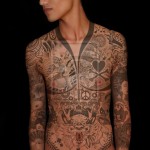 |
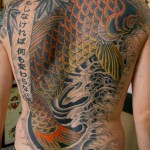 |
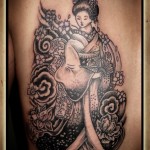 |
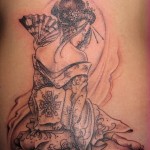 |
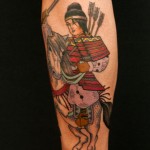 |
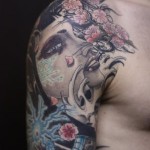 |
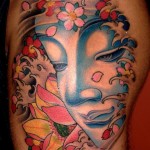 |
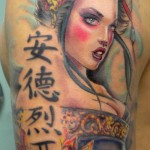 |
 Tattoo Fonts For Women and Women Tattoo Fonts Gallery For Men and Women
Tattoo Fonts For Women and Women Tattoo Fonts Gallery For Men and Women
